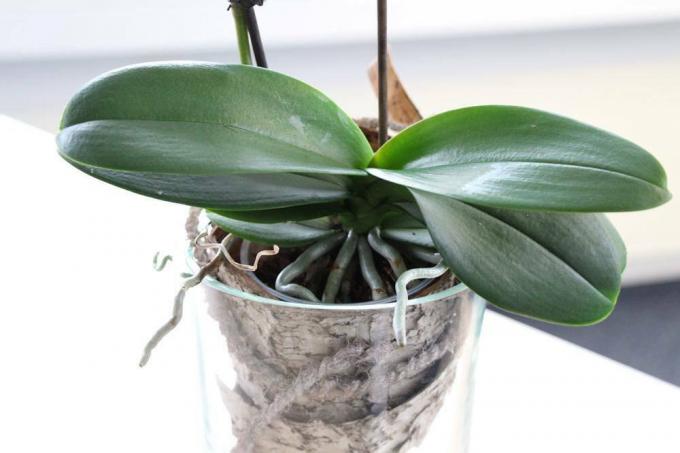
table of contents
- advantages
- options
- Hydroponics
- Block culture
- Orchids in the glass
- Orchid species
- care
- Location
- to water
- Fertilize
Many of the orchid species that come from the tropics and subtropics do not grow in the ground, but rather cling to the tops of the jungle trees with their roots. The roots of these so-called epiphytes or epiphytes need more oxygen and air than the roots of "normal" plants growing in the ground. In conventional potting soil, these orchids would rot quickly due to lack of oxygen and moisture. That is why a culture without soil - for example in a glass - is preferable.
advantages
Benefits of Soilless Cultivation in Orchids
Epiphytic orchids - d. H. those that are in their natural environment on trees etc. sit up - do not need any soil anyway. These species can be found in pine bark, coconut fiber, white peat or seramis or a mixture can be cultivated or completely without substrate. Only terrestrial orchids such as cymbids or Venus shoe orchids require a soil mixture of pine bark and seed or young plant soil. The orchid soil should be as coarse as possible, because the substrate serves less as a water and nutrient store, but gives the plant support and ensures that there is enough air in the large gaps between the substrate chunks Pot. However, since water and nutrients are only added by watering, a culture in substrate is basically not necessary.
The completely substrateless culture offers interesting advantages:
- always enough light and air at the roots
- The plant's water requirement is immediately visible: do not water if the roots are green
- Watering is only necessary if the roots are white
- Substrate-free culture very good for allergy sufferers or people with allergies. suitable for sensitive people
- because fungal spores and other allergens are common in flower substrates
- Orchid culture without soil at the same time without allergens
- pests and diseases often introduced in purchased orchid soil
- Soilless culture in a glass is an interesting eye-catcher
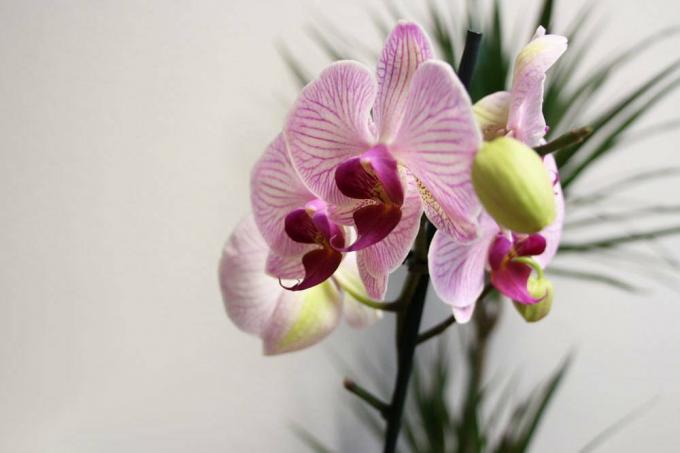
options
What are the possibilities of orchid cultivation without soil?
In addition to the substrateless culture in the glass - which is not suitable for all types of orchids - there are other ways to keep the beautiful flowers without soil. Some species prefer certain shapes: while terrestrial orchids, for example, in a completely soil-free Culture in the glass do not become happy, epiphytically growing species feel themselves especially in the block culture well. So before you decide on a form of cultivation, it is best to look at it beforehand specific needs of the selected orchid species: These can be very different from each other differentiate.
Hydroponics
Hydroponics works entirely without a substrate; instead, expanded clay or clay granules are used to stabilize the plant in the pot. However, this form of plant culture is only partially suitable for orchids because the roots do not grow in water. Instead, they rot if they are constantly in waterlogging. If you still want to hydroponically grow your orchids, you should follow these guidelines.
- Always fill the water level indicator to “optimum”, never to “maximum”
- Orchid roots should never reach into backwater
- Immediately remove and wash damaged roots. Wash through expanded clay
- only use very coarse expanded clay - because of the better permeability
- Halve the dose for liquid fertilizers, but fertilize more frequently
- When moving, wash the substrate carefully - risk of rot
Block culture
The block culture gets by without a planter or soil. It is particularly suitable for epiphytically growing orchids such as the popular Phalaenopsis. For this purpose, the orchids are tied to pieces of wood (for example oak, beech or softwood with firm bark). A special plant material, usually sphagnum moss (also known as swamp moss), is required to tie it up. The plants themselves are attached with copper wire, soft binding wire or a cut nylon stocking. Be very careful when tying up, under no circumstances should parts of plants or roots be squeezed. But never let the roots or even the plants themselves just hang loose, because this will detach the roots from their base and eventually die.
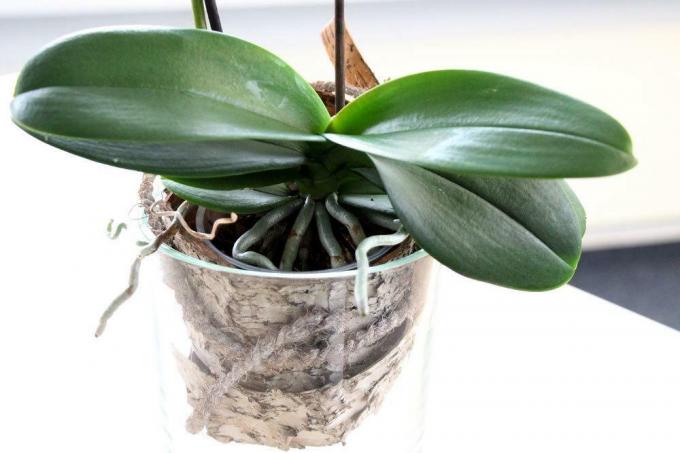
Tip: The block culture only succeeds with really high humidity, as is possible in a greenhouse, in a showcase or in a terrarium. Even orchids that have been tied up are only fertilized with half the recommended concentration, but correspondingly more frequently.
Convert orchids to block culture - this is how it works:
If you want to convert your epiphytic orchids to the more natural block culture, it is best to proceed as described below.
- Prepare the pad
Provide a base made of cork or wood of the appropriate size with a wire hook at the top or in the middle. Then cover them evenly with damp sphagnum.
- Prepare the orchid
First remove old roots and leaves from the orchid and carefully rinse out any remaining substrate. Now place the roots on the mat and distribute them evenly.
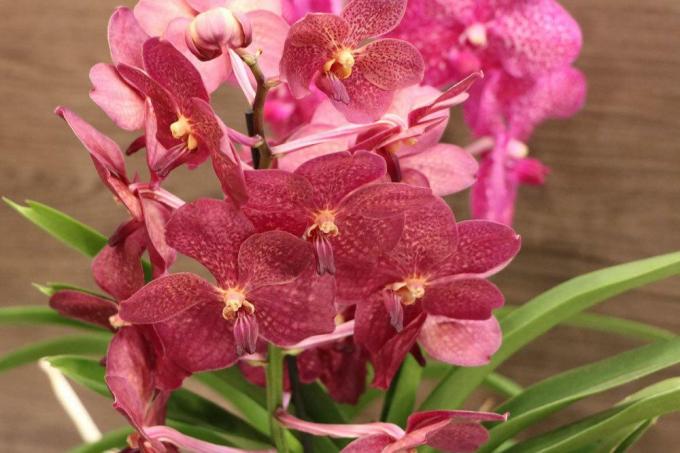
- Cover the roots
Cover the roots with moist sphagnum up to just below the root neck. You can leave very long roots sticking out to the side.
- Tie up the orchid
Now tie everything tightly with binding wire, but not too tight. Start at the root neck. Finally, cut the wire and knot it carefully.
Tip: Orchids grown in pots are best converted to block culture in spring, whereby it is better to grow very large plants Baskets should be placed: These specimens are endangered because the roots naturally dry out easily with block culture. If you spray the plant and roots more often, the change will be easier and the orchid will get used to it more easily.
Orchids in the glass
The completely substrateless culture in the glass is very attractive to look at and especially suitable for many epiphytic species. Put the plant with bare roots in a tall glass with a wide opening - especially hyacinth glasses are just right for this purpose. When switching from pot to glass culture, make sure that no substrate residues are left on hanging from the roots: These only promote rot, which is why the roots are thoroughly cleaned have to. To do this, rinse the roots with running, lukewarm water and take care not to kink or otherwise injure the sensitive parts of the plant. After inserting, fill approx. Put an inch of rainwater into the glass so that the roots hang slightly in the water. They soak up quickly and turn green.
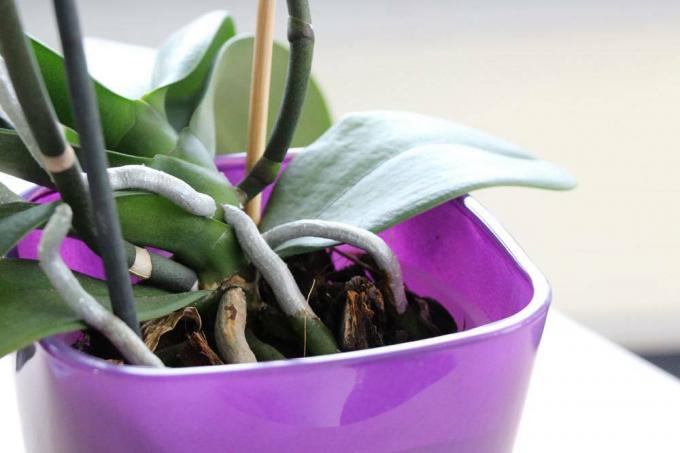
Tip: The glass is the right size if the orchid sits firmly in it and without wobbling back and forth - even without a supporting substrate. If the orchid is still too loose, it is better to choose a smaller container.
Orchid species
Which types of orchids are suitable for growing in a glass?
For a substratum-free culture in the glass, epiphytically growing orchids are particularly suitable. These plants, also known as epiphytes, come mainly from the warm and humid tropical and tropical regions. subtropical rainforests. Their living conditions in the room should also be designed accordingly: warm, humid and bright - the latter, however, not necessarily directly sunny. The following species are perfect for a glass culture.
Vanda
- from Southeast Asia, up to 50 centimeters high, very floriferous and with a long flowering period
Aerides
- from Southeast Asia, up to 40 centimeters high, very long flowering time
Ascocentrum
- from Southeast Asia, up to 40 centimeters high, floriferous, forms flower clusters in intense colors
Neofinetia
- from East Asia, up to 15 centimeters high, small, pretty flowers, difficult to cultivate
Tip: For the culture in the glass, choose smaller or smaller ones. Slow-growing orchids: Species that grow very large do not find support in this form and also often have to be tied up or tied up. be supported with the help of a rod. In addition, you can only choose species whose roots are insensitive to light.

care
Caring for orchids in the glass properly - this is how it works:
To ensure that you can enjoy the magnificent flowers of the orchids for a long time, it is immensely important to care for them appropriately. Basically, orchids are not necessarily easy to care for, although the requirements can vary greatly. Some orchid species, such as many Phalaenopsis hybrids, are considered to be quite easy to care for and often thrive without problems the windowsill - provided they have enough (but not too much!) light, are properly watered and adequately fertilized. Since especially tropical orchids such as Vanda and the closely related species Aerides, Ascocentrum and Neofinetia are kept in the glass, the following information applies to them. Other orchids, on the other hand, have different needs.
Location
Location and light
Like all plants, orchids also need light in order to be able to carry out photosynthesis. Most species that grow in the light shade of other jungle plants cannot tolerate direct sun. As plants of the tropics and subtropics, however, they are used to receiving almost the same number of hours of light. The length of the day near the equator is around 12 hours all year round - with us, on the other hand, orchids receive up to 16 hours of light in summer and often only two hours in winter. This is why additional light is usually necessary in dark locations and during the winter months so that the plants can thrive. Conversely, however, too high a light intensity can be harmful to the plants: especially in spring and summer, direct rays of the sun can burn the sensitive leaves.
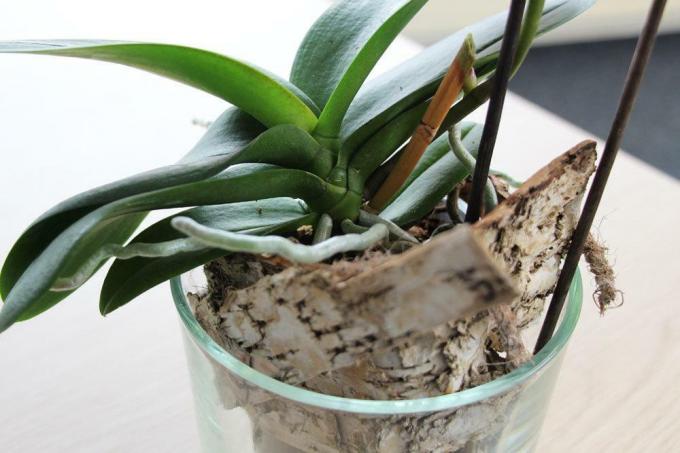
to water
With substrateless culture in the glass, you have to make sure that the orchids do not dry out. Healthy plants have firm, leathery leaves with a glossy surface. However, if it is too dry for the plant, the leaf surface becomes dull and pale, and the leaves fold up and are soft and pliable. Pay particular attention to these points when supplying water.
- in the glass always approx. Let water stand an inch high
- Empty and refill water weekly
- Do not water orchids cultivated without soil
- but instead dive or spray
- Spray orchids daily with room temperature water
- before spraying again, the roots should be dry
- green roots don't need water yet
- exclusively lime-free resp. use decalcified water
- Keep the humidity constantly high
- In the leaf axils as well as in the heart at the end of the shoot, no water should remain
- both lead to putrefaction
- always spray in the morning, then the plant can dry off during the day
- Flowers must not get wet
Tip: The biggest problem with caring for Vandeen and their relatives on the windowsill is dry air and, associated with it, slow drying of the plant. As an immediate measure in the event of drought, soak the roots in water for two hours until they are soaked in moisture.
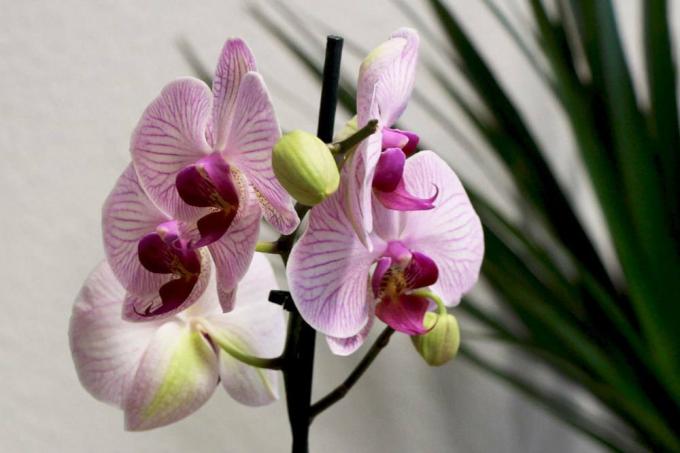
Fertilize
In the case of a substratum-free culture, the orchids should be fertilized every two weeks between June and November. In December and January, however, there is no fertilization. Provide nutrients to the plant as follows.
- Soak the roots in a liquid fertilizer solution for ten minutes
- Plant should soak up liquid
- only use liquid orchid fertilizer
- however, only mix half of the concentration recommended for potted orchids
- otherwise the salt content is too high for the roots
Tip: Do not choose house plant fertilizers for your orchids, always choose a special orchid fertilizer. In addition to nutrients, it contains all the important trace elements.
